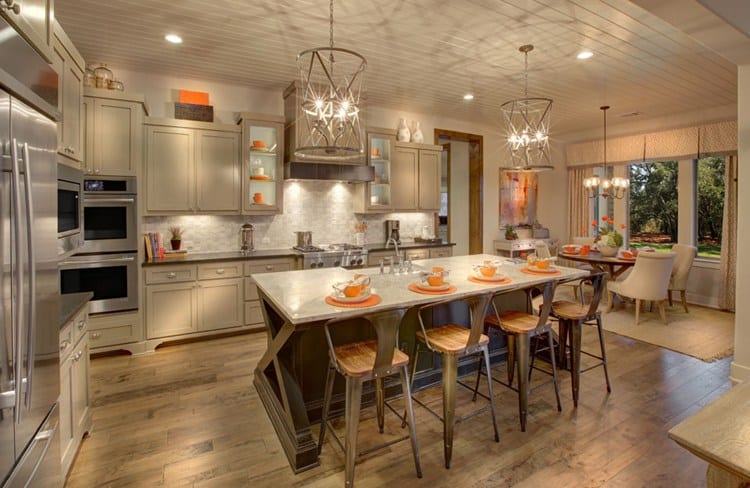
Photo: Drees Homes
The importance of lighting is a pretty widespread topic in the design world. In fact, I’m sure you’ve heard it mentioned many times on TV shows and in magazines. It’s easy to brush lighting off and call it overrated, but believe me, the way your home is lit can make your decor look bland or it can enhance it.
Lighting is like your contouring makeup—it creates shadows and highlights for interest. Lighting can definitely make or break a space and it’s hard to know what you need. In a new build, you’re typically offered basic options to start with, and recessed lights (also called can lights or pot lights) are an amazing addition if you’re able to add them. From there, however, let’s look at how you should layer your lighting for each room of your home.
Pro tip: I am a big believer in the dimmer switch. They can be used everywhere, and trust me, they are a game changer!
Entryway
Overhead Lighting
You want a ceiling light fixture (or fixtures) that will light up the entire space. Depending on the size of your foyer and ceiling height, add as many or as few lights as you need to make the space bright. My favorite ceiling light fixture is the recessed light. They’re the most inconspicuous and get the job done best. If you want to have a designer moment, too, then consider adding a decorative fixture like a chandelier or pendant light.
Mood Lighting
This could be a lamp on a console table by your mirror or sconces on the wall. I just love having some form of subtle light that softly illuminates the entry. This type of light can create a warm, moody effect when used late at night, too.
Living Room
Overhead Lighting
Similarly to the entryway, you want the living room to be well lit for certain activities, like playing board games with the family or doing homework with the kids. It helps to have the option to flood the room with recessed lighting when you need it.
Lamps
Sometimes you only need to use a portion of your living space, like curling up in a corner chair to read a magazine or write in a journal. It’s nice to have either a floor lamp or a couple of table lamps that you can use exclusively to light that part of the room. I envision someone in their cozy chair with a small reading lamp, cup of tea in hand and a good book. Sounds like my kind of night!
Cabinetry Lighting
If you have built-ins or a TV unit, they should always have under cabinet lighting. This can be easily achieved, as you can do-it-yourself by heading down to your local IKEA or by investing a bit more money and having a contractor customize the unit for you. It makes such a huge difference and I never install built-ins without them.
Kitchen
Overhead Lighting
The kitchen is definitely a task space, so it needs to be well lit. Add recessed lights to keep the space bright when you need it. Decorative pendants above an island help light what is probably the most-used surface in the kitchen.
Cabinet Lighting
Under-cabinet lighting is especially important in the kitchen because it illuminates the countertops below. Interior cabinet lighting works well in glass cabinets to showcase displayed china or other special items.
Dining Room
Center Fixture
To me, a dining room just needs a center fixture—either a chandelier/pendant or multiple pendants—something to ground the table and establish the room. The tabletop itself is all you have to light, in my opinion, so if you don’t have a budget for added recessed lights. A decorative fixture above the table is sufficient. If you’re blessed with a large dining room and have other furniture in there, you can decorate those areas with lamps or sconces flanking a mirror above a buffet.
Bedroom
Overhead Lighting
For the bedroom, you can choose between a center fixture or recessed lights — or both! Remember to think through how you use your bedroom. Do you work in your bedroom? Or do you primarily relax in there? That’ll dictate how lit you want your bedroom to be.
Bedside Lighting
This is an obvious one. My newest favorite way to light bedside tables is with wall mounted lamps. They can be hardwired like a sconce or just mounted with a cord that plugs in. This frees up precious space on your nightstand, too.
Lamps
If you have a larger bedroom, you may want a floor lamp near a reading chair or a table lamp on a dresser, but these forms of lighting are more decorative and used to fill up the room.
Bathroom
Overhead Lighting
I may sound like a broken record, but my favorite overhead lights are still recessed lights, especially in another task-oriented space such as the bathroom. You wouldn’t want to be going through those motions without enough light … I’ll leave it at that!
Mirror Lighting
Having enough light over the mirror and sink to illuminate your face is also a necessity. You can add lighting in several ways, such as pendants over the vanity or sconces above or flanking the mirror. Whatever you prefer, you need lights near the mirror so you can see yourself well enough for tasks such as brushing your teeth, putting makeup on, washing your face or good ol’ checking yourself out.

Ashley Freeman is a Toronto-based interior designer who leads her design firm to capture the fullness and richness of life through materials and finishes. See her featured on Apartment Therapy, the Contemporist and Umbra.

 5 Fabrics that Last (and Look Good!) for Your Busy Family Sofa
5 Fabrics that Last (and Look Good!) for Your Busy Family Sofa